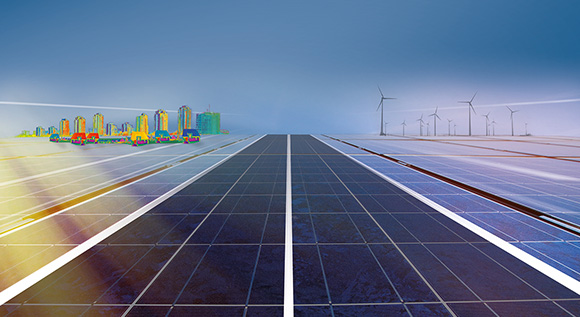Taking stock of the energy reforms
Renewables are now our number-one source of electricity, and power consumption is down, but we need to continue to improve on energy performance. The Fourth Monitoring Report shows where we are in our energy transition, highlighting areas where we have made headway – and the ones where we need to do more.
 © kreativmandat – ivone delazzerböhmer / Lulu Berlu – Fotolia / kflgalore – Fotolia / smuki – Fotolia / zlikovec – Fotolia
© kreativmandat – ivone delazzerböhmer / Lulu Berlu – Fotolia / kflgalore – Fotolia / smuki – Fotolia / zlikovec – Fotolia
Greenhouse gas emissions down by 40 per cent, energy consumption down 20 per cent, renewables accounting for more than a third of our electricity consumption. These are some of the ambitious targets the German government wants to achieve by 2020. Much has already been achieved in some of these areas; others will need additional attention. The Fourth Monitoring Report, which was adopted by the Federal Cabinet on 18 November, shows where we are in our energy transition.
Federal Minister for Economic Affairs and Energy Sigmar Gabriel explained: “We are making good progress on delivering the energy transition: renewables are now Germany’s number-one source of electricity. The German government has also realigned the framework for grid expansion and for our electricity market. However, the energy transition will only be a success if we continue to make the overall system as good as possible. For this to work, we need to scrutinise each of the areas and fields in which the energy transition is happening. The monitoring report provides us with the relevant data.”
Renewables – Germany’s number-one source of electricity
Solar and wind energy, and biomass are now Germany’s most important source of electricity. Last year, electricity from renewable sources accounted for 27 per cent of Germany’s consumption; in the first half of this year, its share rose above 30 per cent for the first time. This means that Germany is well on track when it comes to expanding the use of renewables in electricity generation.
Some homework to do on energy efficiency
The less energy we use, the better. After all, energy that does not have to be produced in the first place is the most cost-efficient and climate-friendly energy of all. This is why energy efficiency is the second pillar of the energy transition alongside the expansion of renewables. The good news first: Germany reduced its energy consumption by 4.7 per cent last year, compared to 2013, bringing it down to the lowest level since 1990. Much of this reduction can be attributed to the mild winter.
At the same time, Germany has some catching up to do when it comes to boosting its final energy productivity. This is a way of measuring how much energy goes into goods and services, i.e. their energy efficiency. On average, Germany’s energy performance increased by an annual 1.6 per cent between 2008 and 2014, which is less than the 2.1 per cent envisaged by the German government in its energy concept. The German government has responded by including various measures targeting this gap in its National Action Plan for Energy Efficiency of December 2014, which is gradually being implemented.
Carbon emissions are falling
Between 2013 and 2014, Germany succeeded in reducing its carbon emissions by 4.3 per cent. Greenhouse gas emissions are down approx. 27 per cent compared to 1990. By 2020, Germany wants to reduce its greenhouse gas emissions by an ambitious 40 per cent at least. This will require additional action to be taken, which is why the German government launched its 2020 Climate Action Plan last December. Some of the additional measures set out in this document have already been put into practice.
Electricity prices and spending on fossil fuels are both down
Our future energy supply should be both green and low-cost. This is why, back in 2014, the Federal Ministry for Economic Affairs and Energy overhauled the funding scheme for renewables in Germany. The reforms are proving effective, with the average German household paying less for electricity – the first reduction of this kind in a decade. On average, trading prices for electricity were down 10 per cent last year, and they have continued to fall in 2015. The renewables surcharge started to stabilise in 2014.
At the same time, Germany has also been spending less on imports of fossil fuels. Last year, Germany imported oil, gas, and coal worth 81 billion euros, down from the 2013 figure of 95 billion euros. Whilst much of these savings can be attributed to lower commodity prices, Germany has also cut down on the volume of these imports.
The Monitoring Report – An annual update of the facts relating to the energy transition
The German government’s Energy for the Future monitoring process regularly reviews the progress made in the transformation of Germany’s energy system, providing answers to questions including: What action has been taken? What are the effects? Will we achieve our targets, or do we need to do some fine-tuning? At the heart of the monitoring process is the annual Monitoring Report. The purpose of this report is to condense the reams of statistical information on energy that is available, thus making it more accessible. Furthermore, the report provides an assessment of the progress made to date, and a preview of the steps that lie ahead.

